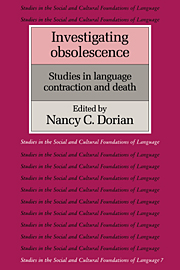Book contents
- Frontmatter
- Contents
- List of maps
- List of contributors
- Preface
- Map
- Dedication
- Introduction
- I Focus on context
- II Focus on structure
- 11 Problems in obsolescence research: The Gros Ventres of Montana
- 12 The structural consequences of language death
- 13 On signs of health and death
- 14 Case usage among the Pennsylvania German sectarians and nonsectarians
- 15 Estonian among immigrants in Sweden
- 16 The incipient obsolescence of polysynthesis: Cayuga in Ontario and Oklahoma
- 17 Urban and non-urban Egyptian Nubian: Is there a reduction in language skill?
- 18 Some lexical and morphological changes in Warlpiri
- 19 Language contraction and linguistic change: The case of Welland French
- 20 Lexical innovation and loss: The use and value of restricted Hungarian
- III Invited commentaries
- Bibliography
- Index of languages
- General index
15 - Estonian among immigrants in Sweden
Published online by Cambridge University Press: 08 January 2010
- Frontmatter
- Contents
- List of maps
- List of contributors
- Preface
- Map
- Dedication
- Introduction
- I Focus on context
- II Focus on structure
- 11 Problems in obsolescence research: The Gros Ventres of Montana
- 12 The structural consequences of language death
- 13 On signs of health and death
- 14 Case usage among the Pennsylvania German sectarians and nonsectarians
- 15 Estonian among immigrants in Sweden
- 16 The incipient obsolescence of polysynthesis: Cayuga in Ontario and Oklahoma
- 17 Urban and non-urban Egyptian Nubian: Is there a reduction in language skill?
- 18 Some lexical and morphological changes in Warlpiri
- 19 Language contraction and linguistic change: The case of Welland French
- 20 Lexical innovation and loss: The use and value of restricted Hungarian
- III Invited commentaries
- Bibliography
- Index of languages
- General index
Summary
Introduction
The results of intensive language contact can have the effect of accelerating internally motivated changes in the system of the less-used language, and direct influence from the majority language will be difficult to resist. The changes in the minority language will, however, not be abrupt but will proceed step-by-step. In this chapter I will discuss the changes in the objective case-marking system in Estonian spoken as a minority language in Sweden. The Estonian objective case-marking system is much more complex than the Swedish one: this gives rise to the kind of development reported for another minority language under pressure, where “a system of morphological markers is confined primarily to a single high-frequency member of the word class concerned”, and “competing structures that have the same semantic value, but different constraints, show movement toward a single favored structure” (Dorian 1983:161,160).
Sweden as a multilingual and multicultural country
Sweden has been a multicultural country for a very long time with two indigenous minorities within its borders: the Finns in the Swedish part of the Torne Valley at the Finnish border, and the Lapps, who probably were the original population of northern Scandinavia. There has also been immigration to Sweden during several periods of Swedish history (e.g. Arnstberg and Ehn 1976; Wande 1984). Some ethnic groups have maintained their culture and ethnic identity while others have been absorbed into the Swedish majority.
Estonians, Latvians, and Lithuanians came to Sweden as refugees during World War II, mainly in 1944, in total approximately 35,000 people, and they were followed by labor-market immigration mainly in the 1960s and 1970s.
- Type
- Chapter
- Information
- Investigating ObsolescenceStudies in Language Contraction and Death, pp. 227 - 242Publisher: Cambridge University PressPrint publication year: 1989
- 8
- Cited by



